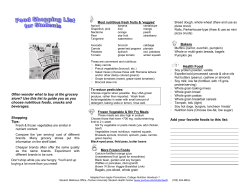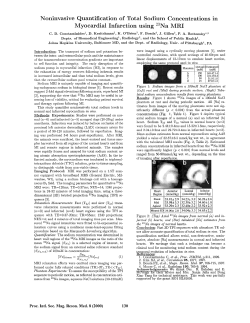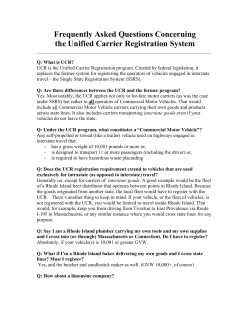
Summary of Product Characteristics Fleet Enema 133 Ready to use, pre-lubricated, disposable
Summary of Product Characteristics Fleet Enema 133 Ready to use, pre-lubricated, disposable enema 1. NAME OF THE MEDICINAL PRODUCT Fleet Enema 133 2. QUALITATIVE AND QUANTITATIVE COMPOSITION Each 100 ml of enema contains: Dibasic sodium phosphate heptahydrate 6 gr. Monobasic sodium phosphate monohydrate 16 gr. Sodium content per 100ml: approximately 5gr. For a full list of excipients, see section 6.1. 3. PHARMACEUTICAL FORM Rectal Solution (Enema) 4. 4. CLINICAL PARTICULARS 4.1 Therapeutic indications Cleaning the colon before surgery, child birth or medical examinations. 4.2 Posology and method of administration Posology: Adults, Elderly and children over 12 years old: According to physician consideration, one bottle of 133 ml (delivered dose 120 ml) or 250 ml (delivered dose 240 ml), not more than once daily. Method of administration: For rectal use only. minutes. Disposable after single use. Results usually obtained in 1 to 5 Bottle must be shaken before use for dispersion of the sediment. Remove protective cover from tip before use. When administering the product, gently insert the enema into the rectum with the tip pointing toward the navel. Insertion may be made easier by having the patient bear down as having a bowel movement. Care during insertion is necessary due to lack of sensory innervations of the rectum and due to possibility of bowel perforation. Once inserted, gently squeeze the bottle until nearly all the liquid is expelled. If resistance is encountered on insertion of the nozzle or in administering the solution, the procedure should be discontinued. Forcing the enema can result in perforation and/or abrasion of the rectum. 4. 3 Contraindications Fleet Enema is contraindicated in patients with: Hypersensitivity to the active ingredients or to any of the excipients of the product. Conditions causing decreased gastric motility, e.g., o known or suspected gastrointestinal obstruction o paralytic ileus o anorectal stenosis o imperforate anus o congenital or acquired megacolon o Hirschsprung's disease Undiagnosed gastrointestinal pathology, e.g., o symptoms of appendicitis, intestinal perforation or active inflammatory bowel disease o undiagnosed rectal bleeding o congestive heart failure o dehydration and generally in all cases where absorption capacity is increased or elimination capacity is decreased Clinically significant impairment of renal function. 4.4 Special warnings and precautions for use Do not use Fleet enema when nausea, vomiting or abdominal pain is present unless directed by a physician. Patients should be advised to expect liquid stools and should be encouraged to drink clear liquids to help prevent dehydration. Use with caution in: elderly or debilitated patients and in patients with uncontrolled arterial hypertension, ascites, heart disease, rectal mucosal changes (ulcers, fissures), colostomy or pre-existing electrolyte imbalance as hypocalcaemia, hypokalaemia, hyperphosphataemia, hypernatraemia and acidosis may occur. Where electrolyte disorders are suspected and in patients who may experience hyperphosphataemia, electrolyte levels should be monitored before and after administration of Fleet Enema. The product should be used with caution in patients with abnormal renal function. Where the clinical benefit is expected to outweigh the risk of hyperphosphataemia. Rectal bleeding or failure in bowel evacuation after using Fleet Enema (evacuation should normally occur within 5 minutes of administration) may indicate a serious condition. No further administrations should be given and the condition of the patient should be assessed by a physician. Fleet Enema should be administered following the instructions for use and handling (see section 4.2). Patients should be warned to stop administration if resistance is felt because forced administration may cause local damage. Keep all medicines out of the reach and sight of children. Using more than one enema in 24 hours can be harmful. Do not use any fleet Enema in children under 12 years of age. When using Fleet Enema, patient may experience anal discomfort. Careful consideration of the use of enemas in children and elderly with comorbidities in general is recommended. In those cases where complications are reported, these groups of patients are often involved. Use with caution in patients who are taking medications known to prolong QT interval. Since Fleet Enema contains sodium phosphates, in all patients there is a risk of elevated serum levels of sodium and phosphate and decreased levels of calcium and potassium and consequently hypernatremia, hyperphosphatemia, hypocalcemia, hypokalemia may occur which could result in metabolic acidosis, tetany, renal failure, QT prolongation and/or, in more severe cases, multi-organ failure, cardiac arrhythmia/ arrest and death. This is of particular concern in children with megacolon or any other condition where there is retention of enema solution, and in patients with co-morbidities, particularly gastrointestinal, renal and neurological disorders. If any patient develops vomiting and/or signs of dehydration, measure post administration labs (see section 4.9). Patients with conditions that may predispose to dehydration or those taking medications which may decrease glomerular filtration rate, such as diuretics, angiotensin converting enzyme inhibitors (ACE-Is), angiotensin receptor blocker (ARBs), non steroidal anti-inflammatory drugs (NSAIDs), should be assessed for hydration status prior to use and managed appropriately. (see section 4.5) Also perform pre-administration and post-administration labs tests for patients when required. 4.5 Interaction with other medicinal products and other forms of interaction No other sodium phosphates preparations including sodium phosphates oral solution or tablets should be given concomitantly. Electrolyte disturbances and hypovolemia from purgation may be exacerbated by inadequate oral fluid intake, nausea, vomiting, loss of appetite, or use of diuretics, angiotensin converting enzyme inhibitors (ACE-Is), angiotensin receptor blocker (ARBs), non steroidal anti-inflammatory drugs (NSAIDs), lithium and calcium channel blockers or other medications that may affect electrolyte levels, and may result in metabolic acidosis, tetany, impairment of renal function, QT prolongation and, in more severe cases multi-organ failure, cardiac arrhythmia/ arrest and death. As hypernatremia is associated with lower lithium levels, concomitant use of Fleet Enema and lithium therapy could lead to a fall in serum lithium levels with a lessening of effectiveness. 4.6 Pregnancy and lactation As there is no relevant data available to evaluate the potential for foetal malformation or other foetotoxic effects when administered during pregnancy Fleet Enema should only be used as directed by a physician at the time of delivery or postpartum. As sodium phosphate may pass into the breast milk, it is advised that breast milk is expressed and discarded for up to 24 hours after receiving the Fleet Enema. 4.7 Effects on ability to drive and use machines Not relevant. 4.8 Undesirable effects The frequencies of adverse reactions to Fleet Enema are not known (cannot be estimated from the available data). Adverse reactions that have been reported are presented below by System Organ Class and Preferred term. Immune System Disorders Hypersensitivity e.g. urticria, pruritus Metabolism And Nutrition Disorders Dehydration Hyperphosphataemia Hypocalcaemia Hypokalaemia Hypernatraemia Metabolic acidosis Gastrointestinal Disorders Nausea Vomiting Abdominal pain Abdominal distension Diarrhoea Gastrointestinal pain Pruritis ani General Disorders And Administration Site Conditions Chills Rectal irritation Blistering Stinging Pruritus Pain Anal discomfort Proctalgia 4.9 Overdose Overdosage (more than one enema in a 24 hour period), use in children or in obstructed patients, no return of enema solution, retention time greater than 10 minutes or failure to have a bowel movement within 30 minutes of enema use may lead to severe electrolyte disturbances, including hypernatremia, hyperphosphatemia, hypocalcemia, and hypokalemia, as well as dehydration and hypovolemia, with attendant signs and symptoms of these disturbances (such as metabolic acidosis, renal failure, and tetany), QT prolongation, and in more severe cases, multi-organ failure, cardiac arrhythmia/ arrest and death. The patient who has taken an overdose or who has retained the product for more than 10 minutes should be monitored carefully. If any patient develops vomiting and/or signs of dehydration, measure post administration labs (phosphate, calcium, potassium, sodium, creatinine, GFR and BUN). Recovery from the toxic effects can normally be achieved by rehydration. In severe cases correction of electrolyte changes by providing calcium and magnesium salts (10% calcium gluconate) while promoting elimination of exogenous phosphorus and the use of dialysis should be considered. 5. 5. PHARMACOLOGICAL PROPERTIES 5.1 Pharmacodynamic properties ATC classification: A06AG01 Sodium phosphate enema Fleet Enema will act as a saline laxative when administered by the rectal route. Fluid accumulation in the lower bowel produces distension and promotes peristalsis and bowel movement with only the rectum, sigmoid and part or all of the descending colon being evacuated. 5.2 Pharmacokinetic properties Colonic absorption is probably minimal, but it has been reported that asymptomatic hyperphosphataemia up to 2–3 times above normal phosphorus levels occurs in nearly 25% of individuals with normal renal function after administration of ORAL sodium phosphate containing colonic preparations. Data for rectal solutions has been generated by a small, open-label, healthy volunteer company sponsored study which looked at both 250mL (high volume) and 133mL sodium phosphate enemas. This study confirmed a transient increase in serum phosphate above the upper limit of normal in 30% of subjects, with mean phosphorus levels falling after the 10-minute sample under normal conditions the greatest phosphorus absorption occurs in the small bowel which is never reached from rectal administration. 5.3 Preclinical safety data No preclinical safety studies have been performed. 6. PHARMACEUTICAL PARTICULARS 6.1 List of excipients Sodium benzoate Sodium methyl parahydroxybenzoate Propyl parahydroxybenzoate Sodium hydroxide Water purified 6.2 Incompatibilities None reported or expected 6.3 Shelf life 3 years 6.4 Special precautions for storage Store below 25oC. 7. LEGAL STATUS 133 ml bottle (delivered dose 120 ml)- over the counter medicine (OTC) 8. MARKETING AUTHORISATION HOLDER Dexcel Ltd., 1 Dexcel street, Or-Akiva 3060000, Israel.
© Copyright 2025













